General Appearance
- Reposition
As able to maximise exposure and assess-ability. - Maximise exposure
Folding blankets down and in to the midline allows rapid and near-complete exposure whilst still preserving some modesty.
| Component | Inspection |
|---|---|
| General |
|
| Respiratory |
|
| Cardiovascular |
|
| Neurological |
|
| Endocrine and Metabolic | |
| Renal and Fluid |
|
| Gastrointestinal |
|
| Haematological | |
| Integumentary |
|
| Trauma | |
| Infective | |
| Malignant | |
| Toxic | |
| Immune |
|
| Congenital | |
| Obstetric |
|
Features
Respiratory
- Cheyne-Stokes respiration
- Alternating episodes hyperpnoea followed by apnoeic spells
- Apnoea may last up to 45s, but is usualy 5-10s
- Generally indicative of acute cerebral or chronic cardiac pathology
- Physiologic in infants and at high altitude
- Alternating episodes hyperpnoea followed by apnoeic spells

- Biot breathing
Similar to Cheyne-Stokes, but abrupt alteration between apnoea and hyperpnoea and less regular intervals.- Indicative of pontine or brainstem injury
Abdominal motion indirectly indicates the function of the diaphragm.
- Apneustic breathing
Irregular respiration rate and tidal volume, classically with an end-inspiratory hold prior to commencing the next breath.
- Paradoxical breathing
Inward movement of the chest while the abdomen raises during inspiration, which occurs in:- Upper airway obstruction
- Severe respiratory distress
- Diaphragmatic dysfunction
- Obstructive breathing
Expiratory airflow limitation may lead to:- Active abdominal contraction during expiration
- Slow and incomplete descent of the chest
- Pursed-lip expiration
Generation of PEEP, maintaining opening of small airways. - E-time > I-time
- Restrictive breathing
Prolonged, forceful inspiration due to inspiratory airflow limitation.
Obstructive and restrictive breathing can occur in the same patient.
- Trepopnoea
Dyspnoea occurring in one lateral position but not the other, signifying worse disease in the non-dependent lung which occurs due to poorer V/Q matching when the diseased lung is in the dependent position.
Cardiovascular
- Orthopnoea
Dyspnoea relieved in the sitting or standing position, due to a ↓ in VR and pulmonary venous congestion.
Inability to lie flat is a significant marker of severe RV failure, tamponade, or impending airway obstruction.
- Platypnoea
Dyspnoea relieved by recumbency, generally due to intracardiac (right-to-left) or intrapulmonary shunts that are worsened due to the ↓ in West Zone 3 that occurs in the upright position.
- Centralisation
Re-distribution of central blood volume away from the peripheries, leading to:- Extensive mottling
- Diaphoresis
- Piloerection
- Cold skin
- Loss of peripheral pulses
- Confusion secondary to cerebral hypoperfusion
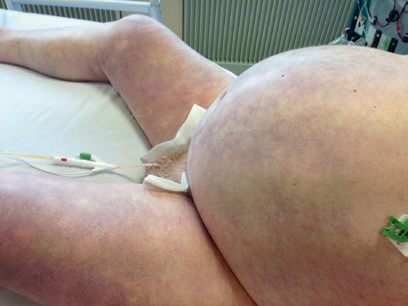
- Peripheral perfusion
↓ Peripheral blood flow occurs early in most shock states, leading to ↓ capillary refill and temperature. Caveats include:- Feet are typically affected earlier than hands
- Localised hypo-perfusion
- Vaso-occlusive disease
- Embolism
- Environmental temperature
Central capillary refill is less affected by environmental conditions but is prolonged only in severe hypoperfusion; consequently it is much more specific although less sensitive.
- Livedo reticularis
Lace-like mottling of the skin occurring due to hypoxaemia in vessels along the watershed margins between regions supplied by different ascending arterioles. May occur due to:- Vasospasm
- Thrombosis
- Hyperviscosity
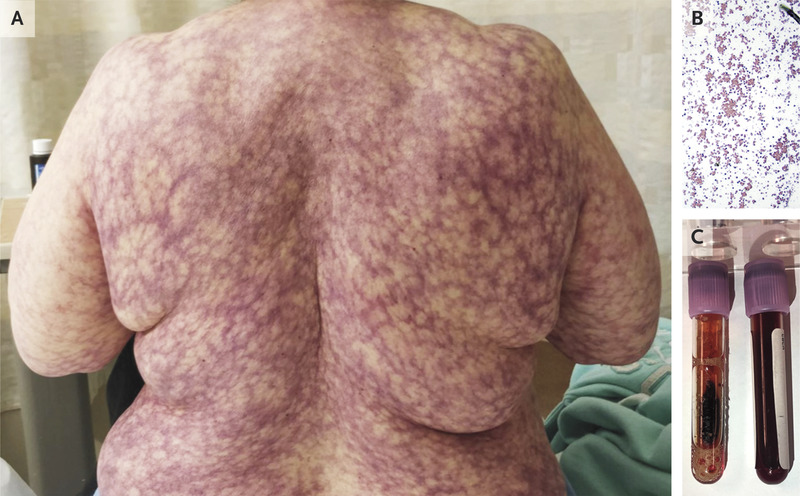
- Pitting oedema
Pitting oedema occurs due to extravasation of fluid into the interstitium. In general:- Subjectively puffy fingers is the earliest sign
- Clinically detectable oedema requires a 2-3L ↑ in extracellular fluid volume
- Cardiac oedema is:
- Symmetrical
- Generalised
- Dependent
- Ankles and legs in ambulant patient
- Sacrum and thighs in bedridden patient
- Generalised oedema:
- Occurs with capillary leak associated with severe illness
- May occur at the trunk before spreading peripherally
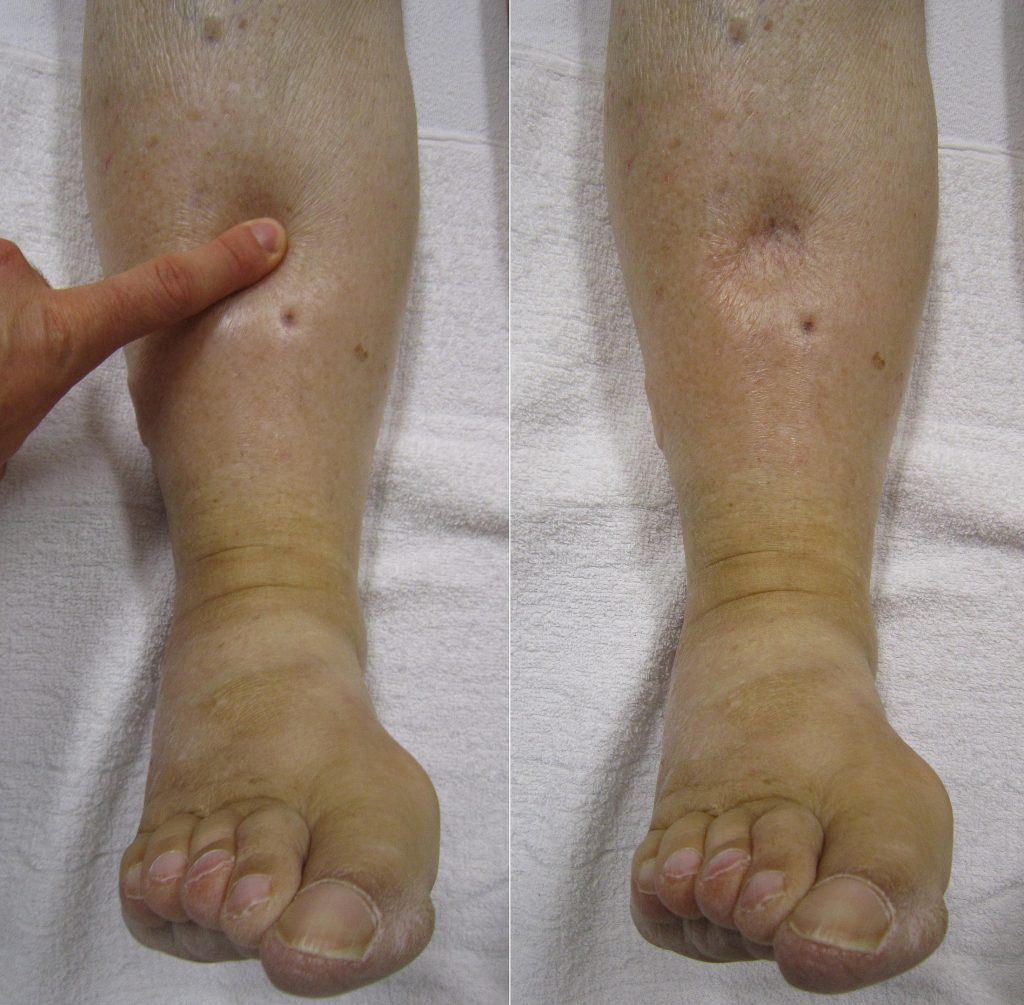
Neurological
- Hoarse voice
- Laryngeal trauma
Intubation. - Localised neck swelling
- Carotid surgery
- ENT surgery
- Laryngeal nerve injury
- Brainstem pathology
- Stroke
- Thyroid surgery
- Aortic aneurysm
- Aortic dissection
- Brainstem pathology
- Laryngeal trauma
- Slurred speech
- Cranial nerve injury
- Stroke
- Cerebellar injury
- Cranial nerve injury
| Type | Fluency | Comprehension | Repetition |
|---|---|---|---|
| Broca’s aphasia | - | Yes | Yes |
| Wernicke’s aphasia Deafness |
Yes | No | Difficult |
| Conduction aphasia | Yes | Yes | No |
| Transcortical motor aphasia | No | Yes | Yes |
| Transcortical sensory aphasia | Yes | No | Yes |
Renal
- Volume state assessment
Challenging, with very few accurate determinants.- Daily weighing is the most useful method to determine fluid loss and gain
- Specific features of hypovolaemia:
- Dry gingivolabial fold
- Dry axillae
- Skin turgor
Non-specific in geriatric patients.
Dehydration refers to a reduction in total body water, and should be distinguished from hypovolaemia.
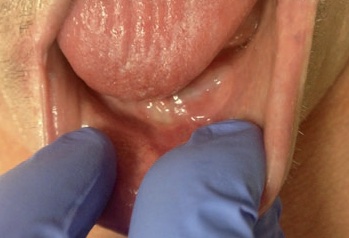
Gastrointestinal
- Foetor hepaticus
Smell of rotten eggs and garlic on the breath due to dimethyl sulphide accumulation, indicating portosystemic shunting.
Integumentary
- Petechiae
Small (<2mm), non-blanching, red lesions that occur in dependent areas due to extravasation of erythrocytes through capillary venules.
- Purpura
Larger non-blanching lesion due to coalescence of petechiae.
- Erythema gangrenosum
Rare skin lesion that begins as a raised red-purple rash that progresses to deep ulceration with central necrosis, associated with:- Rheumatological and immune disease
- Inflammatory bowel disease
- Rheumatoid arthritis
- Haematological malignancy
- P. aeruginosa infection
- Rheumatological and immune disease
- Drug exanthem
Maculopapulous, confluating rash. May be with or without urticaria.
- Toxic epidermal necrolysis
Diffuse large bullae and erosions on skin and mucous membranes.
- Erythema multiforme
Immune-mediated rash characterised by ‘target’ lesions, precipitated by:- HSV
- Medications
- Vaccinations
- Candidiasis


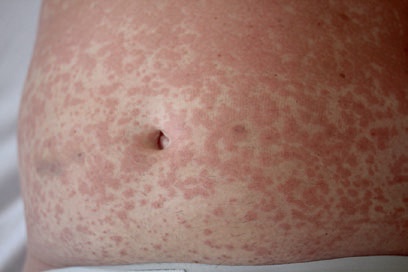

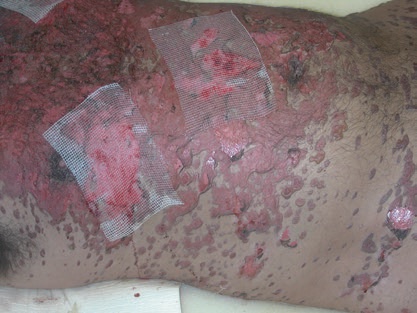
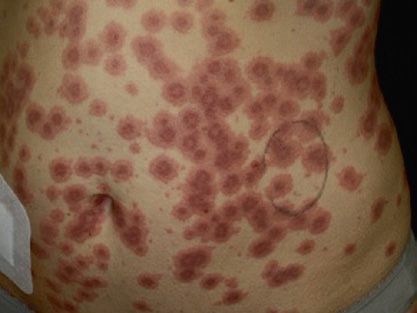
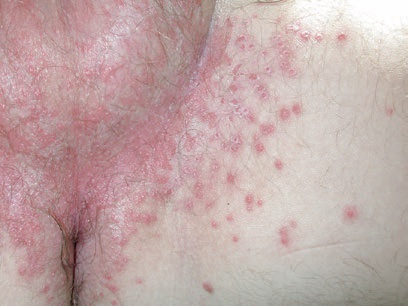
References
- Foot C, Steel L, Vidhani K, Lister B, MacPartlin M, Blackwell N. Examination Intensive Care Medicine. Elsevier Australia; 2011. (Examination series).
- Dünser MW, Dankl D, Petros S, Mer M. Clinical Examination Skills in the Adult Critically Ill Patient. Springer International Publishing; 2018.